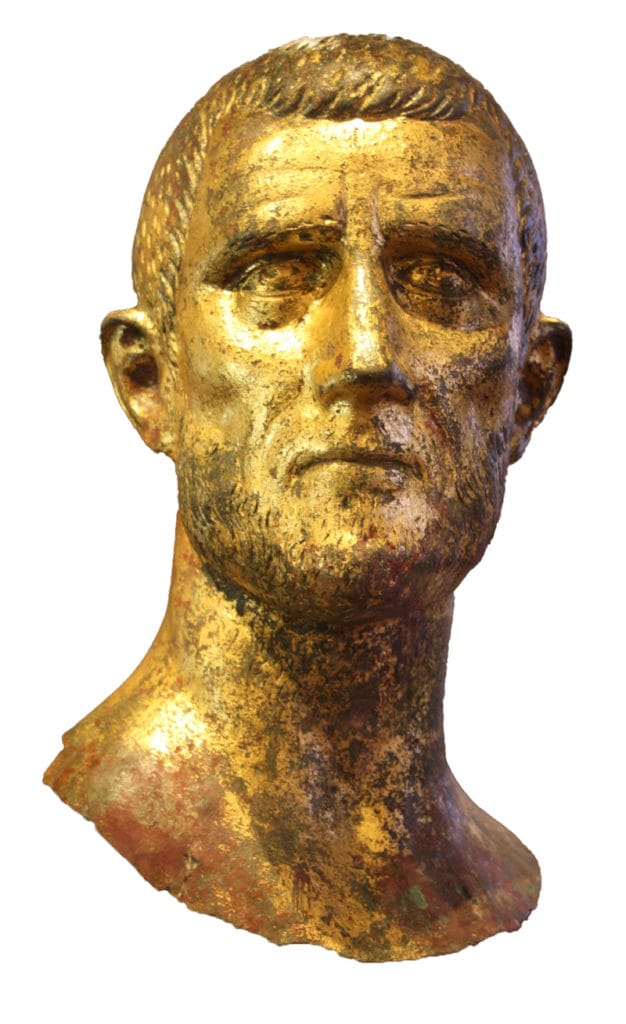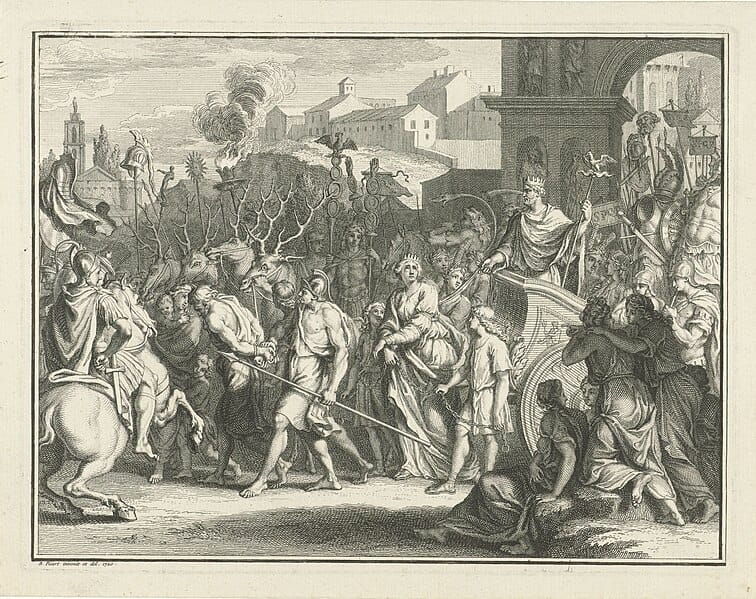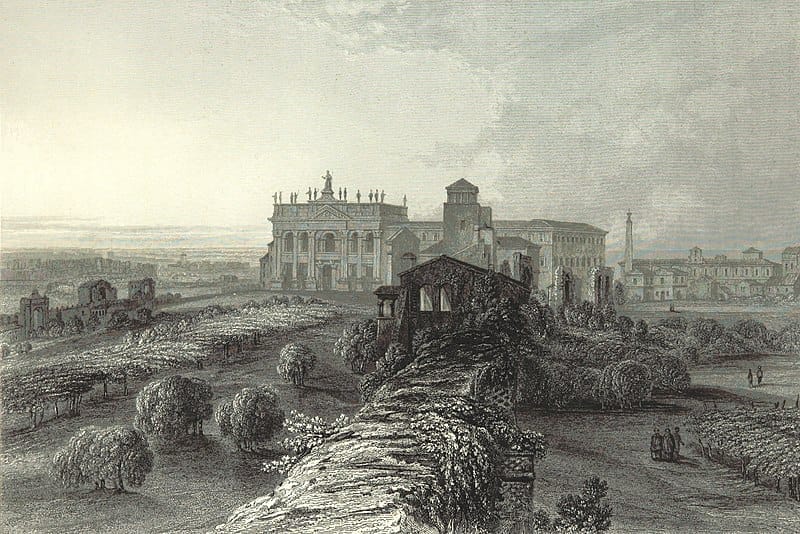Life: AD 214 – 275

- Name: Lucius Domitius Aurelianus
- Born 9 September AD 214.
- Became emperor in August AD 270.
- Wife: Ulpia Severina (one daughter; name unknown).
- Died at Caenophrurium in Thrace, October/November AD 275.
- Deified AD 275.
Early Life of Aurelian
Lucius Domitius Aurelianus was born to poor parents on 9 September AD 214 in Lower Moesia. His father was a tenant farmer of a wealthy senator, Aurelius, after whom the family was named. He rose through the ranks of the army, serving with distinction on the Danube frontier. By AD 268, when Aureolus rebelled against Gallienus, he held a cavalry commanding northern Italy.
It was in this role as cavalry commander that he took part in the siege of Mediolanum (Milan) led by Emperor Gallienus. And there, outside Mediolanum, he became part of the plot to murder the emperor. In fact, he is credited with having had the idea of raising the alarm at night, which caused the emperor to rise from his tent and provide the assassins with their opportunity to strike.
Aurelian was clearly a contender for the vacant throne after the assassination, but Claudius Gothicus was the preferred choice. This was mainly the case due to Aurelian’s reputation as a strict disciplinarian. Claudius II Gothicus instead appointed him ‘Master of the Horse’ and perhaps the most powerful military figure in the empire.
When Claudius II died in AD 270, the throne controversially passed onto Quintillus, the late emperor’s brother. It was very questionable if Claudius II Gothicus had truly named his brother heir to the imperial throne, but once more, the preference of the army and senate for a less strict man than Aurelian made sure he did not become emperor.
Aurelian’s Return to Sirmium
Aurelian moved quickly. He was briefly distracted by an attack by the Goths, who besieged Anchialus and Nicopolis. But once he returned to his base in Sirmium in August AD 270, he laid claim to the throne himself, stating that he, not Quintillus, had been intended for the throne by Claudius II Gothicus. Nobody dared take on the strongest military figure of the empire, and quickly, all the forces changed sides to this stern Danubian commander, abandoning a lonely emperor in Aquileia, who alas committed suicide.
Aurelian, now sole emperor, took to dealing with the most pressing military threat, the Juthungi (Jutes). They had crossed the Brenner Pass and invaded northern Italy. On hearing of Aurelian’s marching towards them at the head of an army, the barbarians immediately began to withdraw. However, he was quicker, and the barbarians were caught up with and severely defeated before they escaped back across the Danube. Had the Romans earlier paid these barbarians subsidies to prevent them from attacking, then Aurelian forced them to agree on a treaty on his terms, without any subsidies.
Then, Aurelian took to Rome, where the senate officially confirmed him as emperor. They were reluctant to do so, and yet they had no choice. But he had no time to lose in Rome. Almost immediately, Aurelian had to go north again, where this time, the Vandals, joined by Sarmatians, had crossed the Danube. Aurelian moved decisively and defeated the barbarians in battle (AD 271). The Vandals were only allowed to move back home after the emperor had asked his troops if they wished to let them do so. Only after this symbolic gesture, and having left hostages and supplied 2,000 horsemen to the Roman cavalry, were the Vandals allowed to withdraw back across the Danube.
Aurelian’s Campaign in the East
And yet, still, the chaos of barbarian invasions continued. The Alemanni, Juthungi, and Marcomanni invaded the empire in force before even the Vandals had finished withdrawing. Once more, northern Italy had to endure a force of barbarians descending upon it from the Alps.
Aurelian rushed back to Italy and met the barbarians at Placentia. But the legions were no match for the barbarians this time, and Aurelian suffered a severe defeat (AD 271). Wild rumors spread through Rome like wildfire. Riots ensued, no doubt encouraged by senators who sought to undermine Aurelian’s authority as much as possible.
If Aurelian had suffered a setback, he was still far from beaten. The barbarians now made one crucial mistake. In order to cover more ground – and so reap more plunder – they split up their huge army into several smaller forces. This gave Aurelian precisely the advantage he wanted. He moved on them and defeated these smaller armies one by one (AD 271). Very few of the barbarians managed to escape back across the Alps. Aurelian did not pursue them, for his presence was more urgently required in Rome.
The riots were still going on, most of all that of the moneyers (coin makers) and their supporters who were holding out on the Caelian Hill. There was a suspicion (well, possibly true) that they had been producing coins containing less precious metals than was required, creaming off the profits for themselves. When Aurelian arrived at Rome, the riots were brutally crushed. Thousands died on the Caelian Hill alone, where the moneyers were crushed. But Aurelian, well knowing where much of the trouble had originated from, also had several senators put to death or had their properties confiscated.
However, Aurelian was aware that, essentially, the troubles within the capital had been sparked off by the fear of invasion, and Aurelian took to building a wall around his unprotected capital in AD 271 – the Aurelian Wall.
Battle of Multiple Fronts
Had Aurelian hardly had any time to spare ever since his accession to the throne, then his reign was now troubled by usurpers. From AD 271 to early AD 272, Septimius rose in Dalmatia, Domitianus in southern Gaul, and also a certain Urbanus staged a rebellion elsewhere. However, it would be wrong to think of these rebels as a real threat. They were only minor pretenders who didn’t last long.
Much more serious was the threat posed to the empire by great parts having been severed from it – in the west by the Gallic empire and in the east by the Queen Zenobia of Palmyra. Aurelian decided that both of these independent states should be destroyed, and first took to oversee the crushing of the Palmyra, by far the greater threat to his empire – as it controlled Egypt and its grain supply. Already in the spring of AD 272, Aurelian set out for the east. On the way, he drove marauding bands of Goths out of Thrace and then crossed the Danube and crushed the Goths in several large-scale battles.
Having now sufficient strength of authority, Aurelian announced the long overdue withdrawal from Dacia. Had Trajan conquered it and turned it into a Roman province, it had ceased to be a practical territory long ago. The population was evacuated and resettled in two territories detached from Moesia and Thrace, which were called Dacia Ripensis and Dacia Mediterranea.
With such momentous decisions behind him, Aurelian continued on eastwards to deal with Zenobia. He marched through Asia Minor (Turkey) unchallenged. Only the city of Tyana resisted him (AD 272). Having conquered the town, he did not allow his troops to sack it, making it clear to any territories that their return to the empire would go without retribution. It was an inspired move, bringing several Greek cities and the entire province of Egypt back into the empire without a fight.
In Syria, he defeated the main force of the Palmyrene army at Immae, 26 miles east of Antioch (AD 272). Soon after, another victory at Emesa brought about the capitulation of Palmyra (AD 272). Zenobia was captured. As Aurelian left for Europe, the defiant city of Palmyra staged another rise, slaughtering its Roman garrison. Aurelian, by then at the Danube campaigning against the Carpi, immediately moved back to Syria and captured the city. This time, there was no clemency shown. Palmyra was systematically sacked, looted, and destroyed.
Military Campaigns Against Galls
The demise of Palmyra now left Aurelian free to deal with the Gallic empire. He proceeded to Gaul and defeated the army of Tetricus on the Campi Catalaunii (Châlons-sur-Marne) (AD 274). In the briefest of time, Aurelian had managed, in a breathless series of military campaigns, what none would have thought impossible. He had not only saved the empire from several serious invasions but had reunited the imperial territories, re-established Roman authority along the empire’s northern borders, and stood unopposed as emperor of the civilized world.

If any of his contemporaries called him manu ad Ferrum (‘iron fist’), then the senate bestowed upon him the title restitutor orbis (‘restorer of the world‘). In a magnificent triumph, he marched through the streets of Rome – the defeated Tetricus and his son of the same name and Queen Zenobia were paraded to the people.
The procession might have been humiliating to the three of them, but Aurelian showed unusual clemency for a Roman emperor. Tetricus was made governor of Lucania, his son was made senator, and Zenobia was moved to Tibur (Tivoli) and was married to a wealthy Roman senator. Alas, Aurelian could put his mind to governing his empire rather than simply fighting for it.
Aurelian’s Monetary System Regulations
He revised the monetary system of the empire. The additional revenue from the recovered provinces, together with thorough reforms, was used to put the empire’s treasury back on a sound footing. Also, measures were introduced to reduce embezzlement, extortion, and corruption among imperial and provincial administrations.
The price of bread in Rome was regulated, and the free distribution of bread was reorganized, and rations of pork, oil, and salt were added to the dole. The bed of the Tiber was cleared, and its banks were repaired. Elsewhere, in Italy, wasteland was reclaimed, and indeed, under his rule, Rome was recovering some of its former splendor.
In late AD 274, Aurelian first dealt with the disorder at Lugdunum (Lyons) and then went north to fight off an invasion of Raetia by the Juthungi (Jutes). But this hard-headed military emperor still had great things in mind, in particular, the re-conquest of Mesopotamia from the Persians. In the summer of AD 275, he set out towards Asia, gathering an army as he continued eastwards. But in October or November, at Caenufrurium, a small Thracian town between Perinthus and Byzantium, he discovered that his private secretary, a certain Eros, had lied to him on a minor matter.
Eros, fearful of what punishment his emperor might have in store for him, told several senior praetorian officers that the emperor sought to have them executed. Eros’ deceit was successful, and Mucapor, a Thracian officer of the praetorians, finally killed Aurelian.
Aurelian was buried at Caenufrurium. He had reigned for five years. In this time, his achievements had been nothing less than colossal. He was deified by the senate soon after his death.

People Also Ask:
What is Emperor Aurelian known for?
Aurelian was an outstanding general and a severe and uncompromising administrator. By increasing the distribution of free food in Rome, he did more for the plebeians than almost any other emperor. His attempt to reform the silver coinage, debased for more than 40 years, met with only limited success.
Why did Aurelian wear a mask?
For God and Empire, he put on the mask and dedicated himself to rescuing the empire from ruin and decay. He, together with his army, marched to Italy and deposed the usurper Quintillus, when the Vandals dared to attack his home, he marched and annihilated every last of them.
What if Emperor Aurelian lived?
If Aurelian had survived, he may have captured Dacia and opened the way for eastern expansion in modern-day Russia. Though one man could not save Rome, he would have given an opportunity for Rome to move to northern Asia and survive.
Was Aurelian killed by Praetorians?
On his way to Byzantium, he was murdered in September or October 275 at Caenophrurium (between Perinthus and Byzantium). The emperor’s secretary had planned a conspiracy, telling the officers of the Praetorian Guard falsely that Aurelian was about to kill them; the troops, therefore, murdered Aurelian.
Was Aurelian a bad emperor?
It also needs to be mentioned that Aurelian is not considered to be a bad Emperor by anyone. He was a good Emperor who reigned at one of the worst times in Roman history, and he did what no other Emperor to that point could, which was quell the Gallic and Palmyrene Empires.

Historian Franco Cavazzi dedicated hundreds of hours of his life to creating this website, roman-empire.net as a trove of educational material on this fascinating period of history. His work has been cited in a number of textbooks on the Roman Empire and mentioned on numerous publications such as the New York Times, PBS, The Guardian, and many more.
